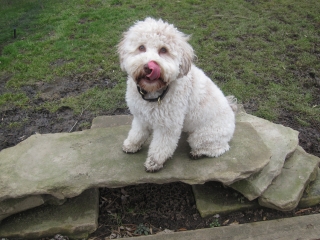Understanding Calming Signals in Dogs

Calming Signals is a term coined by Turid Rugaas, a Norwegian ethologist and dog enthusiast. Her obvious love and long term devotion to observing dogs with their own kind has led to her ground breaking work in articulating these signals into written language (Norwegian, English and no doubt dozens of other written languages -- ironically, dogs speak the same language regardless of country of origin or the spoken language of their people).
I have met Turid Rugaas at dog training conferences and found her knowledge about dog behavior deep and profound. I have found that by truly understanding calming signals in dogs it has made me a much more intuitive dog handler and trainer. Somehow along the way Ms. Rugaas' Calming Signals got thrown into the bag of Stress Signals. Jumbled together, this list of observed behaviors oozes negativity. To me, there seems to be misunderstanding among both dog owners and many dog trainers about how to interpret these signals.
Really learning the language of dogs requires the opportunity to observe many dogs in many situations over many years. For most people the understanding is very limited and it is in that limitation that "bad" behaviors are actually nurtured. Almost like a self fulfilling prophecy.
DIP (Drop in Play) was born of my own desire to create that opportunity to hone what I'd already learned over a life time of observation in the convenience of my own backyard. That is also helps my clients and their dogs is a bonus! Seriously, having the opportunity to observe, measure change, utilize the 3 D's & SMT in the context of an informal 1 - 2 hour play session up to 4x/week with a variety of dogs with a variety of issues and temperaments and breed types and developmental stages over four seasons has been a boon -- for all involved -- me, my animals, my clients, their dogs. Many dog owners have never heard of calming signals, but when receptive to learning more after a clear introduction, embrace them. Owners start to recognize the value of observation to help guide the training plan. Many dog trainers have an assumption that a certain behavior -- a lip lick (See Hazel above), for example, or a play bow (see Trip) -- is a sign of stress and thus a bad thing.
It's very important to understand that assigning a value of "good" or "bad" is a subjective one. Without really understanding the individual steps in the dance of communication, the lightening speed with which dogs communicate, the signal being tossed is simply a signal being tossed. A more useful interpretation instead of "lip licking, my goodness, he is so stressed, poor dog", use the lip licking as a sign that the dog wants to S-L-O-W things down. The slowing down might be obvious -- dogs are being active -- or it might be just within the head of the dog licking his nose. Be mindful when you start to use the language of dogs into your training. Keeping safety in mind, try to observe and interpret behaviors with an eye towards helping, not sabotaging or avoiding any future conflict. Is that scratching a calming signal or an itch?Precedents and antecedents --- what is happening just before and after -- is all part of the language. Taking it out of context is what politicians do in their relentless advertising during National Election Campaigns. It shouldn't be done by you when training your dog or teaching others the wonder of dog behavior.
Here's a slideshow of my JRT, Trip, meeting Mickey the visiting Shih Tzu/Maltese mix one fine fall day. Or just cut and paste this link: http://youtu.be/oPg_zGr6Qfg
To learn more about how to train, consider The Six Pillars of Dog Training Wisdom Program of Study taught at A Better Pet LLC.




